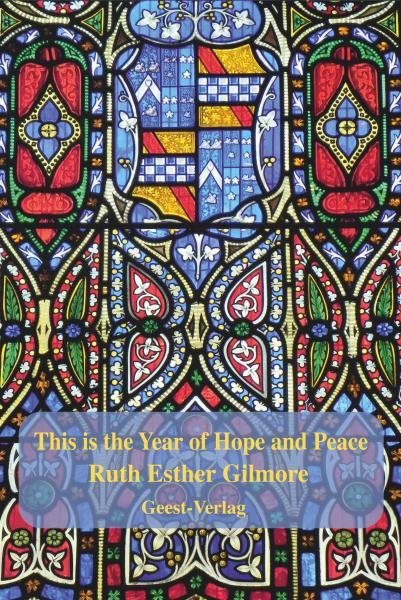Gilmore, Ruth Esther - This is the Year of Hope and Peace
 th Esther Gilmore
th Esther Gilmore
This is the Year of Hope and Peace
Haiku, Senryū, and other poetry forms – Collection
Book cover designed by Ruth Esther Gilmore
Book cover: The window in the St. John’s
Scottish Episcopal Church, Edinburgh
Geest-Verlag, Vechta-Langförden 2022
ISBN 978-3-86685-885-5
272 S., 12,80 Euro
SIGNS OF PEACE
The first light of gems
created a clear vision
beneath my eyelids
a pleated napkin
of leaves and stone walls towered
over parched twined nets
olive trees shaded
the resting workers under
the smoking mountains
unseen a dove broke
olive branches off a tree –
bringing signs of peace
Over the centuries poems, whether with or without accompanying music, have endured war, famine, pestilences, natural and human-made disasters. Poetry is certainly a solid comfort of faith, hope and peace.
The old hymns with their poetical words and melodies are often learned at an early age in life. The modern songs and modern poems come to us in our teenager and later on in our adult years. The first category of music and poems are built on faith, while the latter category contains hope and love. What all music and poetry contains is the promise of peace, whether for our souls and hearts or for our daily lives.
Even now in the never-ending time of loneliness and loss that we are today undergoing, it is our hope for better days which keeps us on our knees, keeps us reading poetry, and keeps us humming old and new melodies.
What happens after the pandemic of 2019-2022 is extremely important. It is up to all of us on this fragile planet to find not only peace in our hearts, but also to forge peace between the nations of our world. Pandemics, climate crises, economic difficulties, natural tragedies, like earthquakes and hurricanes, can only be overcome when everyone works together in trust, faith, and peace.
Foremost, we must work with all of our courage and wisdom on the promotion of peace. This has to start in our schools and cities, in our countries and on their borders, in our politics and our motivations, and in our thoughts and in our dreams.
Everyone on this planet has the single wish – life should be better for our children and for us. The ways we proceed to achieve this wish are different, but we do have the same wish. I am of the opinion that the fulfillment of this wish is only possible if we have peace.
We can do great acts of kindness if we have peace. Only in peaceful times can we save nature, eradicate sickness and poverty, build our infrastructures and cities, connect our communities and give every child a promising secure future – a future where everything is possible and absolutely nothing is impossible.
With peace we can move mountains. With peace we can continue to go about our daily lives. With peace we can find the needed courage and hope to overcome all difficulties. With peace we can listen to music and compose poetry. With peace we can save nature. With peace we can save ourselves and our children. With hope and peace we can live on.
This Haiku, Senryū and other poetry forms – Collection adheres to the golden rules of poetry and like liquid gold, after being melted and formed, it also changes into unique structures. The outward appearances of poems have been molded to describe precisely the themes of hope and peace, but without altering the valued soul of poetry.
This Haiku, Senryū, and other poetry forms – Collection has been written in the enduring forms of poetry as well as in the future-building forms of literature in order to blaze a trail and to erect bridges of peace between all nations.
There are no titles as the introduction lines are the names of the inspiring places and the themes of hope and peace. These places and themes are either on the road maps of our nations or may be found deep within our hearts and souls. In our daily lives we need music and poetry, hope and peace, love and faith to keep our hearts and souls protected.
This is the year of music, poetry, and literature and most important of all:
This is the year of hope and peace.
Ruth Esther Gilmore











